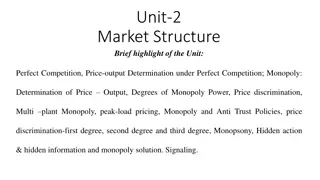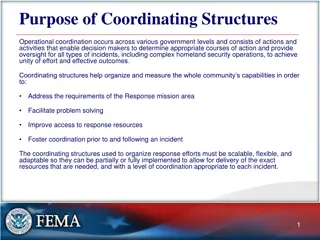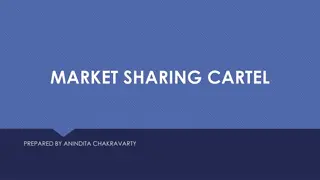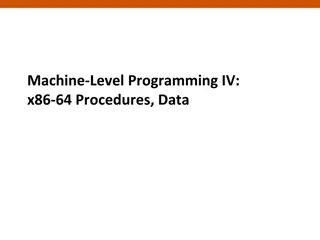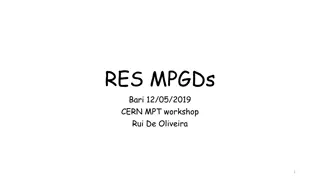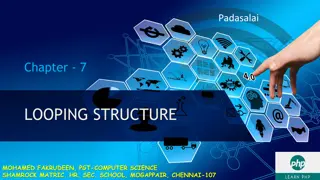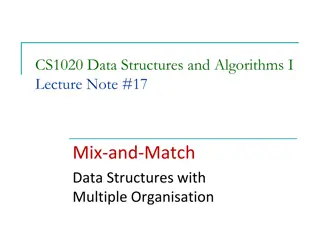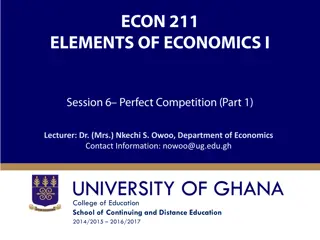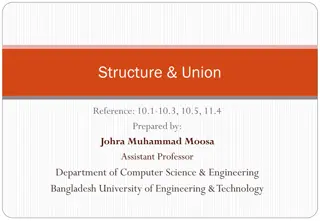Market Structures
Economists analyze market structures to determine the level of competition among businesses in an industry. Perfect competition is an ideal model where many buyers and sellers exist, products are standardized, entry and exit into the market are easy, and buyers and sellers act independently to set prices. This ensures a competitive environment with no single entity controlling prices, leading to optimal consumer choice and market efficiency.
Download Presentation

Please find below an Image/Link to download the presentation.
The content on the website is provided AS IS for your information and personal use only. It may not be sold, licensed, or shared on other websites without obtaining consent from the author.If you encounter any issues during the download, it is possible that the publisher has removed the file from their server.
You are allowed to download the files provided on this website for personal or commercial use, subject to the condition that they are used lawfully. All files are the property of their respective owners.
The content on the website is provided AS IS for your information and personal use only. It may not be sold, licensed, or shared on other websites without obtaining consent from the author.
E N D
Presentation Transcript
Market Structures Umesh Ch. Sarma Asstt. Professor Department of Economics Mangaldai College
Market Structures KEY CONCEPT A market structure is an economic model that helps economists examine the nature and degree of competition among businesses in the same industry. WHY THE CONCEPT MATTERS The level of competition in a market has a major impact on the prices of products. The more sellers compete , the more competitive prices will be.
What Is Perfect Competition? Economists classify markets based on how competitive they are Market structure economic model of competition within an industry Perfect competition ideal model of a market economy economists assess how competitiveness of market by where it falls short
The Characteristics of Perfect Competition Characteristic 1: Many Buyers and Sellers No one buyer or seller has power to control price in the market Many sellers means buyers can choose a producer with better price Many buyers means sellers can all sell product at market price lack of demand will not cause sellers to lower prices
The Characteristics of Perfect Competition Characteristic 2: Standardized Product Standardized product one producer s product is identical to another s Perfect substitutes Price is only basis for consumer choice
The Characteristics of Perfect Competition Characteristic 3: Freedom to Enter and Exit Markets Producers can enter market when profitable and exit when unprofitable Regulations do not restrict businesses from entering or exiting
The Characteristics of Perfect Competition Characteristic 4: Independent Buyers and Sellers Neither buyers nor sellers join together to influence price Supply and demand set the equilibrium price Independent action ensures that market stays competitive
The Characteristics of Perfect Competition Characteristic 5: Well-informed Buyers and Sellers Buyers can compare prices Sellers know what competitors charge, what buyers willing to pay Price taker seller that accepts market price set by supply and demand
Competition in the Real World KEY CONCEPTS No perfectly competitive markets; none meet all conditions Imperfect competition market structures that lack one or more of the conditions Some markets come close, such as some wholesale farm products
Competition in the Real World Example 1: Wheat Thousands of growers; decide only how much to produce at market price Many buyers; standardized product; wholesale price easy to determine In reality, several factors can interfere: government subsidies; farmers or buyers sometimes band together
Competition in the Real World Example 2: Chicken Many producers; each chicken is standard sellers can adjust only their production Competition somewhat imperfect because Poultry farmers may join together to influence price Producers may say products differ due to factors such as feed
Monopoly Characteristics of a Monopoly KEY CONCEPTS Monopoly market structure with one seller, no substitutes for product Cartel organization of sellers that agree to set prices, limit output Price maker business without competitors, can set prices Barrier to entry obstacle to entering market include government regulations, size, resources, technology
Characteristics of a Monopoly Characteristic 1: Only One Seller Single business controls supply of product without close substitutes De Beers cartel controlled diamond market in 20th century because produced over half of world s diamond supply bought up diamonds from smaller producers to resell
Characteristics of a Monopoly Characteristic 2: A Restricted, Regulated Market Government regulations allow single firm to control market
Characteristics of a Monopoly Characteristic 3: Control of Prices Monopolists can control prices because there are no close substitutes
Types of Monopolies KEY CONCEPTS Natural monopoly cost of production lowest with only one producer Government monopoly government owns and runs or permits only one producer Technological monopoly one firm owns invention, technology, method Geographic monopoly no other sellers within a region
Types of Monopolies Example 1: Natural Monopoly: A Water Company In some markets, inefficient to have companies competing Example: public utilities that require complex systems economies of scale average production cost falls as production grows Government both supports and regulates
Types of Monopolies Example 2: Government Monopoly: The Postal Service Government runs some businesses that provide goods and services private firms cannot or do not want to provide because of low profits Example: Postal Service has sole right to deliver first- class mail New services and technologies now compete private delivery companies, fax, e-mail, online bill paying
Types of Monopolies Example 3: Technological Monopoly: Polaroid Patent legal registration of invention; gives inventor sole rights enables businesses to recover costs of development Monopoly lasts for time limit of patent or until substitute invented Patent let Polaroid keep Kodak out of instant- photography market simpler cameras, digital cameras, quick processing reduced its market
Types of Monopolies Example 4: Geographic Monopoly: Professional Sports Sports leagues tie teams to cities, regions; limit number of teams owners can charge high ticket prices, sell team merchandise Physical isolation no other supplier in area lets owner control prices Very small market may not support two businesses of same type
Profit Maximization by Monopolies KEY CONCEPTS Monopoly cannot set prices too high faces downward-sloping demand curve raises equilibrium price by producing less than competitive market would Most countries have laws to prevent monopolies
Profit Maximization by Monopolies EXAMPLE: Drug Manufacturer Drug companies maximize profits during patent period afterwards, others market cheaper generic versions Schering-Plough strongly marketed non-drowsy antihistamine Claritin made up to $3 billion per year worldwide with patent after patent ended sales dropped to about $1 billion per year
Other Market Structures KEY CONCEPTS Most real markets fall between perfect competition and monopoly Monopolistic competition many sellers offer similar products one of most common market structures product differentiation sellers try to distinguish their products from similar ones non-price competition use factors other than price to attract customers
Characteristics of Monopolistic Competition Characteristic 1: Many Sellers and Many Buyers Many sellers and many buyers fewer sellers than perfect competition but enough for true competition Each seller chooses product to make, amount to make, price to charge examples include T-shirts, batteries, Pizza restaurants
Characteristics of Monopolistic Competition Characteristic 2: Similar but Differentiated Products Consumer loyalty gained with unique product or apparent difference Sellers use market research to decide how to differentiate product Chains use sophisticated techniques learn consumer lifestyles, tastes focus groups moderated discussions with small groups of consumers survey large numbers of consumers
Characteristics of Monopolistic Competition Characteristic 3: Limited Control of Prices Differentiation gives producers limited control of prices low price distinguishes some products name brands or better quality priced higher Consumers pay extra if they perceive important enough difference will switch to substitute if price goes too high
Characteristics of Monopolistic Competition Characteristic 4: Freedom to Enter or Exit Market No great barriers to entry in monopolistically competitive markets when firms earn profit, other firms enter and increase competition competition can be difficult for small businesses against large ones Some firms start to take losses signal that it is time to exit the market
Characteristics of an Oligopoly KEY CONCEPTS Oligopoly market structure with only a few sellers offering similar product Less competitive than monopolistic competition each firm has large market share percent of total sales in the market Few firms due to high start-up costs expenses of entering market
Characteristics of an Oligopoly Characteristic 1: Few Sellers and Many Buyers A few firms dominate market industry is oligopoly if four firms control 40 percent of market About half of manufacturing industries in United States are oligopolies include breakfast cereals, soft drinks, movies, industrial products
Characteristics of an Oligopoly Characteristic 2: Standardized or Differentiated Products Many industrial products standardized such as flat glass, aluminum firms differentiate by brand name, service, location Many consumer goods are differentiated use marketing strategies, such as focus groups, surveys create brand-name products that can be marketed widely
Characteristics of an Oligopoly Characteristic 3: More Control of Prices Each firm s decisions about supply and price affect entire market If one firm lowers prices, others probably will too no firm gains market share from price drop; all risk losing profits If one raises prices, others may not in order to gain market share Anticipate competitors response to price, output, marketing changes
Characteristics of an Oligopoly Characteristic 4: Little Freedom to Enter or Exit Market High start-up costs such as factories, warehouses make entry hard new firm may sell on small scale; hard to compete with established ones Established firms have resources, patents, economies of scale High investment by firms in oligopoly make exit difficult operations too vast, complex to sell and reinvest easily


